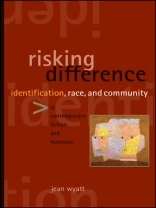Looks at the dynamics of identification, envy, and idealization in fictional narratives by Margaret Atwood, Angela Carter, Sandra Cisneros, Toni Morrison, and others, as well as in nonfictional accounts of cross-race relations by white feminists and feminists of color.
Risking Difference revisions the dynamics of multicultural feminist community by exploring the ways that identification creates misrecognitions and misunderstandings between individuals and within communities. Drawing on Lacanian psychoanalysis, Jean Wyatt argues not only that individual psychic processes of identification influence social dynamics, but also that social discourses of race, class, and culture shape individual identifications. In addition to examining fictional narratives by Margaret Atwood, Angela Carter, Sandra Cisneros, Toni Morrison, and others, Wyatt also looks at nonfictional accounts of cross-race relations by white feminists and feminists of color.
Innehållsförteckning
Acknowledgments
Introduction: I Want to Be You
Part I. Totalizing Identifications
1. The Politics of Envy in Academic Feminist Communities and in Margaret Atwood’s The Robber Bride
2. I Want You To Be Me: Parent-Child Identification in D. H. Lawrence’s The Rainbow and Carolyn Kay Steedman’s Landscape for a Good Woman
3. Identification with the Trauma of Others: Slavery, Collective Trauma, and the Difficulties of Representation in Toni Morrison’s Beloved
Part II. Structures of Identification in the Visual Field
4. Race and Idealization in Toni Morrison’s Tar Baby and in White Feminist Cross-Race Fantasies
5. Luring the Gaze: Desire and Interpellation in Sandra Cisneros’s ’Woman Hollering Creek, ’ Anne Tyler’s Saint Maybe, Angela Carter’s The Magic Toyshop, and Margaret Drabble’s Jerusalem the Golden
6. Disidentification and Border Negotiations of Gender in Sandra Cisneros’s Woman Hollering Creek
Part III. Heteropathic Identifications
7. Toward Cross-Race Dialogue: Cherrie Moraga, Gloria Anzaldua, and the Psychoanalytic Politics of Community
Appendix: The Challenge of Infant Research and Neurobiology to Traditional Models of Primary Identification
Notes
Works Cited
Index
Om författaren
Jean Wyatt is Professor of English and Comparative Literary Studies at Occidental College and the author of Reconstructing Desire: The Role of the Unconscious in Women’s Reading and Writing.











